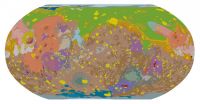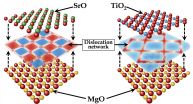(Press-News.org) From this week's Eos: The New Geologic Map of Mars: Guiding Research and Education
Currently, five spacecraft are investigating Mars, and a swarm of new missions to the Red Planet either have been launched or are in development. They are designed to probe the surface, subsurface, and atmosphere with a host of scientific instruments. Where will they make new discoveries? Clues to where they should focus investigations can be gleaned from the planet's new geologic map.
From AGU's journals: History of storm surge in Florida strongly underestimated
The observational hurricane record for northwestern Florida is just 160 years long, yet hurricane activity is known to vary strongly over thousands of years. Digging back into the prehistorical hurricane record, Lin et al. find that scientists' reliance on such a narrow slice of observations has led them to sorely underestimate the frequency with which large hurricanes have slammed into Florida's Gulf Coast.
Based on historical records, northwestern Florida gets hit by a hurricane packing a five-meter (16-foot) storm surge every 400 years. Incorporating long-term paleohurricane records, the authors find that the frequency of such a storm is actually closer to every 40 years.
When strong storms batter the shore, waves can carry sediment far inland. Digging down into the sediment record, researchers can reproduce the occurrence of past storm surge. Using a hurricane model and storm surge sediment observations, the authors calculated the intensity and frequency of past hurricanes in Florida's Apalachee Bay. They find that while the frequency of hurricanes hitting the Gulf Coast has remained relatively the same over the past few thousand years, the storms' average intensities have been, at times, much higher than during the past 160 years.
Based on their paleohurricane storm surge observations, the authors suggest that, historically, northwestern Florida would see a storm surge of 6.3 meters (20.7 feet) every 100 years, 8.3 meters (27.2 feet) every 500 years, and 11.3 meters (37.1 feet) in a worst case scenario event. A storm surge of eight meters (26 feet), they say, would push tens of kilometers inland.
The authors suggest that assessments of hurricane risk in other coastal regions may also be biased by relatively short observational records, though the direction and magnitude of that bias is not obvious.
INFORMATION:
Click here for the online version of This Week From AGU.
Click here to register for access to AGU journal papers and Eos, the newspaper of the Earth and space sciences.
The American Geophysical Union is dedicated to advancing the Earth and space sciences for the benefit of humanity through its scholarly publications, conferences, and outreach programs. AGU is a not-for-profit, professional, scientific organization representing more than 62,000 members in 144 countries. Join our conversation on Facebook, Twitter, YouTube, and other social media channels.
This week from AGU: New geologic map of Mars, storm surge in Florida
2014-09-23
ELSE PRESS RELEASES FROM THIS DATE:
Water-quality trading can reduce river pollution
2014-09-23
DURHAM, N.C. -- Allowing polluters to buy, sell or trade water-quality credits could significantly reduce pollution in river basins and estuaries faster and at lower cost than requiring the facilities to meet compliance costs on their own, a new Duke University-led study finds.
The scale and type of the trading programs, though critical, may matter less than just getting them started.
"Our analysis shows that water-quality trading of any kind can significantly lower the costs of achieving Clean Water Act goals," said Martin W. Doyle, professor of river science and policy ...
State policies are effective in reducing power plant emissions, CU-led study finds
2014-09-23
A new study led by the University of Colorado Boulder found that different strategies used by states to reduce power plant emissions -- direct ones such as emission caps and indirect ones like encouraging renewable energy -- are both effective. The study is the first analysis of its kind.
The findings are important because the success of the Environmental Protection Agency's proposed Clean Power Plan depends on the effectiveness of states' policies in reducing power plants' carbon dioxide emissions. The plan would require each state to cut CO2 pollution from power plants ...
Big changes in the Sargasso Sea
2014-09-23
Over one thousand miles wide and three thousand miles long, the Sargasso Sea occupies almost two thirds of the North Atlantic Ocean. Within the sea, circling ocean currents accumulate mats of Sargassum seaweed that shelter a surprising variety of fishes, snails, crabs, and other small animals. A recent paper by MBARI researcher Crissy Huffard and others shows that in 2011 and 2012 this animal community was much less diverse than it was in the early 1970s, when the last detailed studies were completed in this region.
This study was based on field research led by MBARI ...
Study finds gallbladder surgery can wait
2014-09-23
LOS ANGELES – (September 23, 2014) –Laparoscopic cholecystectomy, a minimally invasive procedure to remove the gallbladder, is one of the most common abdominal surgeries in the U.S. Yet medical centers around the country vary in their approaches to the procedure with some moving patients quickly into surgery while others wait.
In a study published online Monday in the American Journal of Surgery, researchers found gallbladder removal surgery can wait until regular working hours rather than rushing the patients into the operating room at night.
"The urgency of removing ...
'Bendy' LEDs
2014-09-23
VIDEO:
This is an animation of the micro-rod growth process.
Click here for more information.
WASHINGTON D.C., Sept. 23, 2014 -- "Bendy" light-emitting diode (LED) displays and solar cells crafted with inorganic compound semiconductor micro-rods are moving one step closer to reality, thanks to graphene and the work of a team of researchers in Korea.
Currently, most flexible electronics and optoelectronics devices are fabricated using organic materials. But inorganic compound ...
Diabetes: Complexity lost
2014-09-23
WASHINGTON, D.C., September 23, 2014 -- For millions of people in the United States living with Type 1 or Type 2 diabetes, measuring the daily rise and fall of blood glucose (sugar) is a way of life.
Our body's energy is primarily governed by glucose in the blood, and blood sugar itself is exquisitely controlled by a complicated set of network interactions involving cells, tissues, organs and hormones that have evolved to keep the glucose on a relatively even keel, pumping it up when it falls too low or knocking it down when it goes too high. This natural dynamical balance ...
Future flexible electronics based on carbon nanotubes
2014-09-23
WASHINGTON, D.C., September 23, 2014—Researchers from the University of Texas at Austin and Northwestern University have demonstrated a new method to improve the reliability and performance of transistors and circuits based on carbon nanotubes (CNT), a semiconductor material that has long been considered by scientists as one of the most promising successors to silicon for smaller, faster and cheaper electronic devices. The result appears in a new paper published in the journal Applied Physics Letters, from AIP Publishing.
In the paper, researchers examined the effect ...
Lack of sleep increases risk of failure in school
2014-09-23
A new Swedish study shows that adolescents who suffer from sleep disturbance or habitual short sleep duration are less likely to succeed academically compared to those who enjoy a good night's sleep. The results have recently been published in the journal Sleep Medicine.
In a new study involving more than 20,000 adolescents aged between 12 and 19 from Uppsala County, researchers from Uppsala University demonstrate that reports of sleep disturbance and habitual short sleep duration (less than 7 hours per day) increased the risk of failure in school.
The study was led ...
Moving to the 'burbs is bad for business
2014-09-23
This news release is available in French. Montreal, September 23, 2014 — It's rare to see a Wal-Mart downtown. Big box stores usually set up shop in the suburbs, where rent is cheap and the consumer base is growing. So should smaller stores follow suit?
Not so fast, says Concordia University professor Tieshan Li. His recent study, published in the Canadian Journal of Administrative Sciences, shows that higher profits are had by retailers located furthest from where the market is expanding.
"Those results may seem counterintuitive but the decreased profits are ...
Los Alamos researchers uncover properties in nanocomposite oxide ceramics for reactor fuel
2014-09-23
Nanocomposite oxide ceramics have potential uses as ferroelectrics, fast ion conductors, and nuclear fuels and for storing nuclear waste, generating a great deal of scientific interest on the structure, properties, and applications of these blended materials.
"The interfaces separating the different crystalline regions determine the transport, electrical, and radiation properties of the material as a whole," said Pratik Dholabhai, principal Los Alamos National Laboratory researcher on the project. "It is in the chemical makeup of these interfaces where we can improve ...





